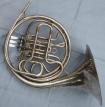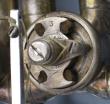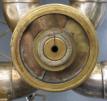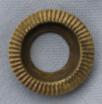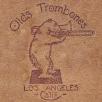
It's a bear!
This page has been superseded; information on this instrument is now on this page.
Super Olds French Horn in F
It isn't widely known, but Olds produced a small number of French horns prior to WWII. In addition to singles like the one shown below, they also made double horns with a "Geyer-style" valve arrangement (i.e., the change valve next to the third valve). Both the singles and doubles used wraps that are unlike those used on the Olds horns produced after WWII; in fact, they are unlike anything I can recall seeing from any other maker. It's thought they were introduced in the late 1930's and discontinued when production was curtailed due to the war. In the partial 1941 Olds catalog on Olds Central, there are listings for French horn cases (in "Special" and "Super" grades) and mouthpieces (three sizes), but the pages listing the horns themselves aren't there. I've seen a couple Super doubles and a Special single F; thus far, I have not seen a Special double. The mouthpiece page of the 1941 catalog mentions that their No. 3 mouthpiece is suited for single Bb horns, so it's possible that Bb singles were produced (or at least planned), but that's slim evidence, and I have never seen an Olds single Bb from this era.
Curiously, the cover of this circa 1950 catalog shows what appears to be a pre-WWII Super double, though the horn is not shown in the catalog. There is a full page dedicated to the Ambassador single (in Bb or F), and a brief mention of a double being in the works. I suspect the double being referred to is the O-45/O-48 design, based on the Conn 6D.
This particular example is a Super Olds single in F. Where the silver plate is worn on the bell, it appears that the underlying material is yellow brass. The "tone control band" is apparently nickel silver, as would be seen on other Super instruments of the era, and is hand-engraved. Also present are the streamlined Super-style braces. The valves have are interesting in that they have a double-stop system (rather that the normal single stop) and an ingenious detented nut and spring system that is looks like it is intended to keep the bearings tight, along with an ornately engraved valve cap.The serial number is in the 1xx range, indicating that Olds used a separate sequence for these instruments.

